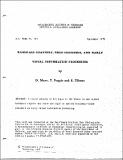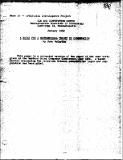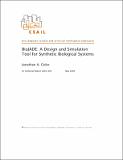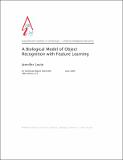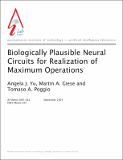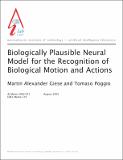Browsing Artificial Intelligence Lab Publications by Title
Now showing items 121-140 of 1835
-
Bagging Regularizes
(2002-03-01)Intuitively, we expect that averaging --- or bagging --- different regressors with low correlation should smooth their behavior and be somewhat similar to regularization. In this note we make this intuition precise. ... -
Bandpass Channels, Zero-Crossings, and Early Visual Information Processing
(1978-09-01)A recent advance by B.F. Logan in the theory of one octave bandpass signals may throw new light on spatial-frequency-tuned channels in early visual information processing. -
Bargaining Between Goals
(MIT Artificial Intelligence Laboratory, 1975-01)Bargaining is a process used to modify conflicting demands on an expendable resource so that a satisfactory allocation can be made. In this paper, I consider the design of a bargaining system to handle the problem of ... -
Basic Solid Mechanics for Tactile Sensing
(1984-03-01)In order to stably grasp objects without using object models, tactile feedback from the fingers is sometimes necessary. This feedback can be used to adjust grasping forces to prevent a part form slipping from a hand. ... -
A Basis for a Mathematical Theory of Computation
(1962-01-01)This paper is a corrected version of the paper of the same title given at the Western Joint Computer Conference, May 1961. A tenth section discussing the relations between mathematical logic and computation has been added. ... -
Basis Reduction Algorithms and Subset Sum Problems
(1991-06-01)This thesis investigates a new approach to lattice basis reduction suggested by M. Seysen. Seysen's algorithm attempts to globally reduce a lattice basis, whereas the Lenstra, Lenstra, Lovasz (LLL) family of reduction ... -
Battling Reality
(1989-10-01)In the four years that the MIT Mobile Robot Project has benn in existence, we have built ten robots that focus research in various areas concerned with building intelligent systems. Towards this end, we have embarked on ... -
The Behavior Language; User's Guide
(1990-04-01)The Behavior Language is a rule-based real-time parallel robot programming language originally based on ideas from [Brooks 86], [Connell 89], and [Maes 89]. It compiles into a modified and extended version of the ... -
A Behavior-Based Arm Controller
(1988-06-01)In this paper we describe a working, implemented controller for a real, physical mobile robot arm. The controller is composed of a collection of 15 independent behaviors which run, in real time, on a set of 8 loosely coupled ... -
Belief Propagation and Revision in Networks with Loops
(1997-11-01)Local belief propagation rules of the sort proposed by Pearl(1988) are guaranteed to converge to the optimal beliefs for singly connected networks. Recently, a number of researchers have empirically demonstrated good ... -
The Bifurcation Interpreter: A Step Towards the Automatic Analysis of Dynamical Systems
(1989-09-01)The Bifurcation Interpreter is a computer program that autonomously explores the steady-state orbits of one-parameter families of periodically- driven oscillators. To report its findings, the Interpreter generates ... -
The Binford-Horn LINE-FINDER
(1973-12-01)This paper briefly describes the processing performed in the course of producing a line drawing from an image obtained through an image dissector camera. The edge-marking pahse uses a non-linear parallel line-follower. ... -
The Binford-Horn LINEFINDER
(MIT Artificial Intelligence Laboratory, 1971-07)This paper briefly describes the processing performed in the course of producing a line drawing from vidisector information. -
Binocular Shading and Visual Surface Reconstruction
(1982-08-01)Zero-crossing or feature-point based stereo algorithms can, by definition, determine explicit depth information only at particular points on the image. To compute a complete surface description, this sparse depth map ... -
A Binocular, Foveated Active Vision System
(1998-03-01)This report documents the design and implementation of a binocular, foveated active vision system as part of the Cog project at the MIT Artificial Intelligence Laboratory. The active vision system features a three degree ... -
BioJADE: A Design and Simulation Tool for Synthetic Biological Systems
(2004-05-28)The next generations of both biological engineering and computer engineering demand that control be exerted at the molecular level. Creating, characterizing and controlling synthetic biological systems may provide us ... -
A Biological Model of Object Recognition with Feature Learning
(2003-06-01)Previous biological models of object recognition in cortex have been evaluated using idealized scenes and have hard-coded features, such as the HMAX model by Riesenhuber and Poggio [10]. Because HMAX uses the same set ... -
Biologically Plausible Neural Circuits for Realization of Maximum Operations
(2001-09-01)Object recognition in the visual cortex is based on a hierarchical architecture, in which specialized brain regions along the ventral pathway extract object features of increasing levels of complexity, accompanied by greater ... -
Biologically Plausible Neural Model for the Recognition of Biological Motion and Actions
(2002-08-01)The visual recognition of complex movements and actions is crucial for communication and survival in many species. Remarkable sensitivity and robustness of biological motion perception have been demonstrated in ... -
Biophysics of Computation: Neurons, Synapses and Membranes
(1984-10-01)Synapses, membranes and neurotransmitters play an important role in processing information in the nervous system. We do not know, however, what biophysical mechanisms are critical for neuronal computations, what ...

